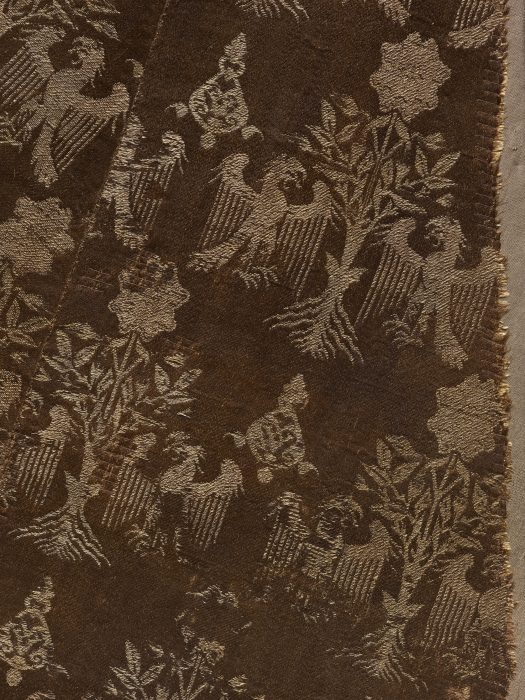
Fragment of a robe of the dukes of Masovia
The fabric originates from the crypt of the last Dukes of Masovia from the Piast dynasty. Stanisław (1501–1524) and Janusz III (1502–1526) were the sons of Konrad Rudy (c. 1448–1503) and the daughter of the Voivode of Vilnius Anna Radziwiłłówna (1476–1522). The causes of the Dukes’ death at such a young age and short interval between their passing have remained a mystery until the present day. The suspected reasons included an inherited proneness to tuberculosis or their debauched lifestyle, yet there were also rumours of poisoning. With the passing of Janusz III, the Masovian line of the Piast dynasty died out, and by virtue of a previously concluded agreement, power in the hitherto separate Masovia was assumed by Polish King Sigismund I the Old (1467–1548, King of Poland 1507–1548).
The tombstone of the Dukes in the Warsaw Archcathedral Basilica of the Martyrdom of St. John the Baptist survived the war turmoil. The temple, funded at the beginning of the 14th century by the Masovian Piasts, and raised one hundred years later to the rank of a collegiate church, was the most important church in Masovia. The Renaissance tomb of Dukes Stanisław and Janusz III was built between 1526 and 1528 upon the initiative of their sister Anna Mazowiecka (1498–after 1557). The tombstone is made of red marble and was probably designed by Bernardino Zanobi de Gianotis (before 1500–1541). The burial place of the Dukes was discovered in the crypt by the northern wall of the chancel in 1953 upon the reconstruction of the temple following destruction suffered during World War II. Scholars used the preserved remnants to create portraits of Stanisław and Janusz III. The investigations confirmed the rumours concerning their massive physiques. The fragments of the Dukes’ robes which were found by archaeologists at the time entered the holdings of the Museum. These are remnants of silk and woollen fabrics, thread loops, buttons, and a fragment of a belt. A female ring was also found in the coffin of Janusz III. We might only guess if it was souvenir inherited from his mother or sister, or his engagement ring.
The featured fabric belongs to the most presentable historic artefacts from the Dukes’ crypt. Its shape is akin to a triangle and it is sewn together of three pieces of dark red, double warp and double weft silk fabric with a twill weave and a cut pile. It is adorned with a bright pattern with the motif of the tree of life crowned with an eight-pointed star, embellished by two eagles with crowns. During that period, such sumptuous silk fabrics were manufactured in several Italian cities: Lucca, Genoa and Venice. The fact that they were imported to Warsaw bears testimony to the wealth and prestige of the local ducal court. Stored at the Museum of Warsaw, the set of historic artefacts discovered in the cathedral crypt contains the oldest remnants of clothing from Warsaw.
Fragment of a robe of the dukes of Masovia
LUKKA; TURN OF THE 16TH C.
BROCADED FABRIC
MHW 16676
64 × 59 CM
Image: ![]()
